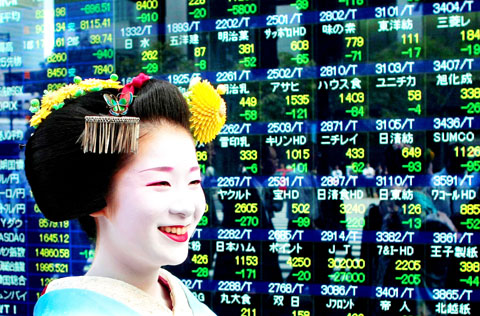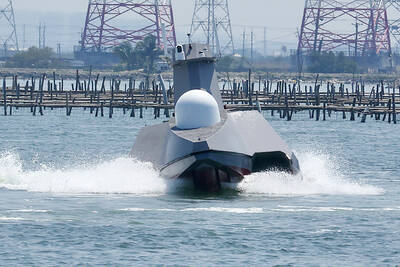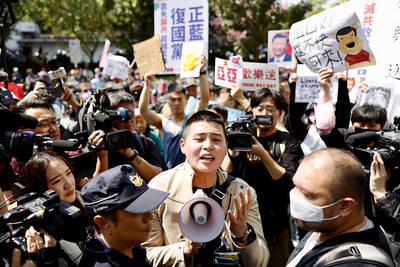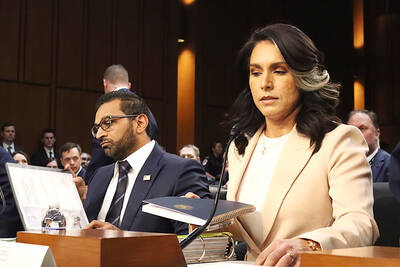Asian stocks plummeted last week, sending the region’s benchmark index to its biggest weekly drop on record, as the deepening credit crisis threatened to push more companies into bankruptcy.
Mitsubishi UFJ Financial Group Inc slumped 20 percent as Asian money-market rates climbed even as the US Federal Reserve and other central banks cut borrowing costs to revive credit lending. BHP Billiton Ltd, the world’s biggest mining company, sank 8.8 percent, while Toyota Motor Corp plunged 21 percent on concern a worldwide slowdown will hurt demand for metals and automobiles.
“It’s pure panic,” said Ivan Tham, Singapore-based head of funds management at the state-backed Kuwait Finance House, which has about US$24 billion in assets.

PHOTO: AP
“You’re seeing companies start to fail because they can’t refinance. Good companies are being sold down aggressively with the bad,” Tham said.
The MSCI Asia-Pacific Index fell 18.7, or 17.8 percent, to 86.0, the biggest weekly decline since the index was created on Dec. 31, 1987.
Japan’s Nikkei 225 Stock Average plunged 24 percent for the biggest weekly decline in its more than 50-year history. Australia’s S&P/ASX 200 Index slumped 16 percent, the biggest rout since 1992. Hong Kong’s Hang Seng Index fell 16 percent, the most since January 1998.
TAIPEI
Markets in Taiwan were closed on Friday for the Double Ten public holiday.
Taiwanese share prices are expected to encounter further downside risks as worries over global economic fundamentals continue to haunt the market, dealers said on Thursday.
With listed companies due to release their the third quarter earnings reports later this month, many investors are reluctant to jump into the trading floor until such uncertainty is removed, they added.
It is possible for the market to test the key 5,000-point level and even fall to the 4,600-4,700 point support next week, while resistance at around 5,200 points may cap any technical rebound, dealers said.
In the week to Thursday, the weighted index was down 611.52 points or 10.65 percent at 5,130.71 after a 3.16 percent fall a week earlier.
TOKYO
Japan’s Nikkei stock index plunged 9.62 percent, dealers said.
The Nikkei dived 881.06 points to end at 8,276.43, the lowest level since May 2003, while the TOPIX index of all first section shares sank 64.25 points, or 7.1 percent, to 840.86.
SYDNEY
Australian shares closed down 8.3 percent, dealers said.
The benchmark S&P/ASX200 plunged 360.2 points to 3,960.7, breaking through the 4,000 barrier to its lowest close in more than five years, while the broader All Ordinaries fell 351.9 points to 3,939.4.
HONG KONG
Shares closed down 7.2 percent, dealers said. The benchmark Hang Seng Index closed down 1,146.37 points at 14,796.87, its lowest closing figure since November 2005.
All 42 companies that make up the Hang Seng Index ended the day lower. Dealers were divided about whether the market has hit the bottom.
SHANGHAI
Chinese share prices closed 3.57 percent lower, dealers said.
The Shanghai Composite Index, which covers A and B shares, was down 74.01 points at 2,000.57. The key index fell 12.8 percent this week, the biggest weekly percentage loss since June 13. The Shanghai A-share index shed 3.56 percent to 2,101.30 points, while the Shenzhen A-share index was down 5.55 percent at 558.34.
SEOUL
South Korean shares closed 4.1 percent lower, recovering some ground after a morning decline of almost eight percent, dealers said.
The KOSPI index ended down 53.42 points at 1,241.47.
SINGAPORE
Singapore shares closed 7.34 percent lower, dealers said. The blue-chip Straits Times Index ended down 154.38 points at 1,948.33 — its lowest close since September 2004.
KUALA LUMPUR
Malaysian share prices closed 3.6 percent lower, dealers said. The Kuala Lumpur Composite Index lost 34.88 points to 934.01, off a low of 931.79.
BANGKOK
Thai share prices closed 9.61 percent lower, dealers said. The Stock Exchange of Thailand (SET) composite index fell 48.03 points to close at 451.96 points.
MANILA
Philippine share prices closed 8.3 percent lower, dealers said. The composite index lost 190.64 points to 2,097.80 points.
WELLINGTON
New Zealand shares dived 4.72 percent, dealers said. The NZX-50 index fell 139.08 points to 2,805.31.
MUMBAI
Indian shares closed down 7.07 percent, dealers said. The 30-share SENSEX index fell 800.51 points to 10,527.85.
SOURCE: AFP AND DPA

ENDEAVOR MANTA: The ship is programmed to automatically return to its designated home port and would self-destruct if seized by another party The Endeavor Manta, Taiwan’s first military-specification uncrewed surface vehicle (USV) tailor-made to operate in the Taiwan Strait in a bid to bolster the nation’s asymmetric combat capabilities made its first appearance at Kaohsiung’s Singda Harbor yesterday. Taking inspiration from Ukraine’s navy, which is using USVs to force Russia’s Black Sea fleet to take shelter within its own ports, CSBC Taiwan (台灣國際造船) established a research and development unit on USVs last year, CSBC chairman Huang Cheng-hung (黃正弘) said. With the exception of the satellite guidance system and the outboard motors — which were purchased from foreign companies that were not affiliated with Chinese-funded

PERMIT REVOKED: The influencer at a news conference said the National Immigration Agency was infringing on human rights and persecuting Chinese spouses Chinese influencer “Yaya in Taiwan” (亞亞在台灣) yesterday evening voluntarily left Taiwan, despite saying yesterday morning that she had “no intention” of leaving after her residence permit was revoked over her comments on Taiwan being “unified” with China by military force. The Ministry of the Interior yesterday had said that it could forcibly deport the influencer at midnight, but was considering taking a more flexible approach and beginning procedures this morning. The influencer, whose given name is Liu Zhenya (劉振亞), departed on a 8:45pm flight from Taipei International Airport (Songshan airport) to Fuzhou, China. Liu held a news conference at the airport at 7pm,

Authorities yesterday elaborated on the rules governing Employment Gold Cards after a US cardholder was barred from entering Taiwan for six years after working without a permit during a 2023 visit. American YouTuber LeLe Farley was barred after already being approved for an Employment Gold Card, he said in a video published on his channel on Saturday. Farley, who has more than 420,000 subscribers on his YouTube channel, was approved for his Gold Card last month, but was told at a check-in counter at the Los Angeles International Airport that he could not enter Taiwan. That was because he previously participated in two

SECURITY RISK: If there is a conflict between China and Taiwan, ‘there would likely be significant consequences to global economic and security interests,’ it said China remains the top military and cyber threat to the US and continues to make progress on capabilities to seize Taiwan, a report by US intelligence agencies said on Tuesday. The report provides an overview of the “collective insights” of top US intelligence agencies about the security threats to the US posed by foreign nations and criminal organizations. In its Annual Threat Assessment, the agencies divided threats facing the US into two broad categories, “nonstate transnational criminals and terrorists” and “major state actors,” with China, Russia, Iran and North Korea named. Of those countries, “China presents the most comprehensive and robust military threat